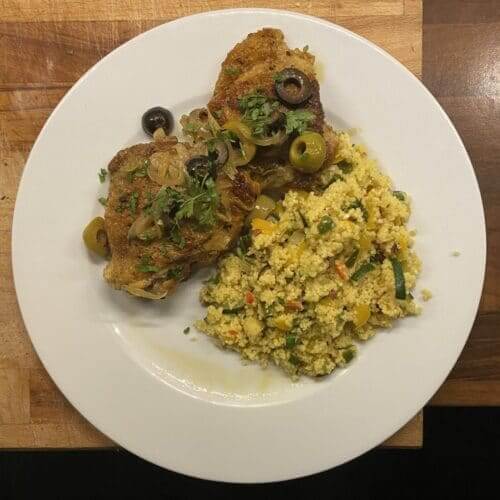Vegetable Couscous
We initially made this one for our Moroccan chicken tagine dish: we needed a side and we had a bunch of veggies to hand, so we came up with this vegetable couscous. The result surprised us.
While it might call to mind the narrow streets of Marrakech, couscous is also a staple in Italy when summer comes and the hot weather hits. Dreaming of pasta and pizza but not willing to go through the effort of cooking, couscous comes to the rescue.
Based on how much fun she’ having going around, Audrey Hepburn was definitely not going around Rome in August in Roman Holidays. I actually feel I can relate more to Anita Ekberg when she throws herself in the Trevi Fountain in La Dolce Vita instead.

Going back to this vegetable couscous, what I love about it is that it ticks all the boxes of the perfect dish:
- Tasty
- Cheap
- Healthy-ish
- Can be adapted to be suitable for different dietary requirements (apart from gluten free)
- Can be prepared in advance and stored for a few days so that you don’t have to cook for a bit
- Makes an excellent summer dish to bring as a side for BBQs
If you don’t have za’atar, I’ll leave a note below on how to make it yourself at home so that you don’t miss out on the zingy, lemony taste of this herb mix that I can promise, makes all the difference.
Time for me to stop blabbing and get to the recipe:

Vegetable Couscous
Equipment
- Chef's Knife
- Mixing bowl
- A couple of sauce pans and/or skillets
- A wooden spoon or spatula
Ingredients
- 1 small onion (finely chopped)
- 1 bell pepper (red or yellow)
- 1 courgette
- 2 tbsp olive oil (divided)
- 2 cloves garlic (minced)
- 1/2 tsp za'atar * (see after recipe to make for yourself if you don't have any premade)
- 1/2 tsp ground coriander
- 1/2 tsp cumin
- 1 lemon (juice)
- 8-12 almonds, roasted
- 250 ml chicken or vegetable broth (1 cup)
- 1 tsp turmeric
- 1 cup dry cous cous
- 1 tbsp fresh coriander
Instructions
- Start by dicing very finely your onion, bell pepper, and courgette. Heat up half of the olive oil in a pan and add the vegetables when it's hot. Let them cook at a medium to medium-high heat for 5-7 mins until slightly browned. Stir frequently.
- While they cook, prepare the dressing by mincing the garlic cloves and adding them to the remaining olive oil along with the za'atar, lemon juice, cumin, and ground coriander. Whisk together and set aside.
- Go ahead and toast the almonds by putting them in a small skillet or sauce pan over medium-high heat, tossing them every 2 mins. Cook for 5-7 mins until darkened. Once cooked, roughly ground them in a mortar (or any other surface of your preference). You can also toast pre-flaked almonds for ease. They're gonna take less time but you need to be extra careful that not to burn them.
- To a small pot, add the turmeric and the chicken or vegetable stock. Whisk together and bring to a boil.
- Place the couscous in a mixing bowl. When the turmeric broth is ready, add it a few splashes at a time, making sure to mix the couscous thoroughly. It should look moist, but not soupy. Cover with clingfilm ideally and let it rest for 5 minutes. In the meantime, chop the fresh coriander.
- Once ready, add the vegetables to the bowl and mix together. Add the dressing, almonds and fresh coriander. Serve away.
Post vegetable couscous thoughts
I briefly mentioned in the original recipe that this vegetable couscous is far from being the traditional Maghreb couscous. I am fascinated by the idea of making couscous from scratch (possibly not during one of the annual British heatwaves), which mainly involves making the grains you eat from scratch from semolina.
And since we love to explore the traditional way, we managed to find a video from Bon Appetit that goes through the process, which seems to have been well-received by the locals.
Interestingly enough, some parts of Sicily (specifically Trapani) incorporated couscous as their own and have their very own way to make it. I’m not sure whether the preparation of the grain itself differs somehow from the original one. What I can tell you is that the Sicilian version is more fish-oriented, rather than chicken or lamb.
Turns out that the sailors that were travelling around the Mediterranean sea during the 16th century got inspired by the couscous that their North-African and Tunisian counterparts were having. And so they thought to just mix the two and here we are.
A note on Za’atar
Truth be told, we found ourselves with some za’atar in the house so we now use it where we see fit. However, I realise it’s not exactly an ingredient that is always to hand (although I seem to understand that it’s getting more popular by the day in the US).
You can probably find it at your local Middle Eastern store or well-stocked supermarket (Tesco and Morrisons have it in the UK, and in the US there’s a whole dedicated website), but in case you’re in a rush and you really want to try this vegetable couscous the same way we made it, you can always substitute with the mix below:
- 2 tablespoons of dried oregano
- 2 tablespoons of sumac (or if you don’t have it, 1 and 1/2 tablespoons of grated lemon peel)
- 2 tablespoons of toasted sesame seeds
- 1 tablespoon of marjoram
- 1 1/2 tablespoon of thyme
Toast the sesame seeds in a hot pan over medium-high heat for a 2-3 mins, tossing every minute or so to ensure they don’t burn. Once toasted, add the mix of dried herbs. Here you go. You have an homemade za’atar mix.
Store it in an airtight container for up to a month.
